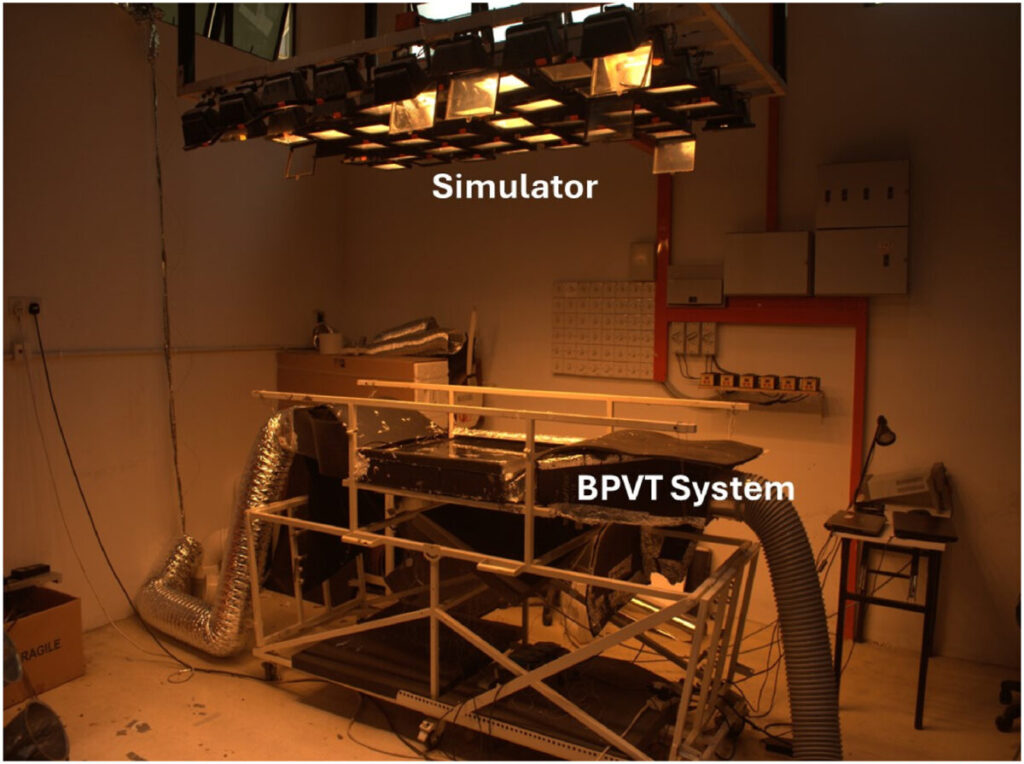Scientists have created a model to study bifacial PV thermal (BPVT) solar panels using jet impingement and built an experimental setup to validate it. They achieved a thermal efficiency of 62.28%, while the electrical efficiency peaked at 11.22%.
An international research group led by scientists from Scotland’s University of Strathclyde conducted an energy, economic and environmental analysis of BPVT solar panels using jet impingement for cooling. The team developed a numerical model of the system and built a realistic experimental setup to validate it. They achieved a thermal efficiency of 62.28%, while the electrical efficiency peaked at 11.22%.
“This study introduces dual-function jet plate reflectors designed to provide cooling and increase light absorption at the back of the BPV module,” the group explains. “Additionally, use of the bifacial module can increase electrical efficiency due to its ability to capture sunlight from both the front and back. These modules are more effective at capturing diffuse radiation (scattered sunlight on cloudy days), allowing them to perform better under changing weather conditions than conventional PV modules.”
The team’s numerical model was set up on MATLAB, using 1D steady-state heat flow. The model assumes that it consists of a bifacial PV panel, an insulated backplate and a jet plate, with one air duct between the jet plate and the PV and another air duct between the backplate and the jet. It calculates temperatures and efficiency using factors such as air mass flow, solar radiation and jet plate cooling effects.
To validate the model, the academic team built an experimental setup. It uses a 36-hole jet plate reflector, a 12-cell bifacial PV panel and airflow channels with a length of 0.025 meters. The packing factor, or the ratio between the surface area occupied by the solar panels and the total surface area available for installation, was tested at 0.22, 0.33 and 0.66, while the air mass flow rate was between 0.014 kg/s and 0.035 lay. kg/sec.
Image: University of Strathclyde, Case Studies in Thermal Engineering, CC BY 4.0
“The ambient air first enters the lower channel before passing through the holes in the jet plate reflector and entering the upper channel. The bottom of the two-sided solar panel is hit by air coming from the top channel. The two-sided solar panel and the surrounding air exchange heat,” the group said. “At the top of the test section, six rows of 48 halogen lamps each serve as solar simulators to simulate solar radiation, according to the collector measurements. Each lamp has a heat flux of 500 W and is 118 mm long.”
By comparing the results of the setup and the model, the latter was validated with an accuracy of 94.53% for thermal efficiency and 98.91% for electrical efficiency. The group was able to input several measurements into the numerical model and found that the systems operate within the temperature and electrical efficiency ranges of 304.39 K to 339.54 K and 9.39% to 11.22%, respectively.
“Conversely, thermal efficiencies correlate directly with air velocity and solar radiation. The system thermal efficiency and exit air temperature range from 33.86% to 62.28% and 302.07 K to 318.75 K, respectively,” the scientists said. “In addition, PV temperature has an inverse relationship with mass flow and a direct relationship with solar radiation. On the other hand, there is an inverse relationship between solar radiation, mass flow rate and electrical efficiency.”
The researchers also conducted an economic and ecological analysis of the system. They assumed a lifespan of 20 years for the BPVT, with eight hours of operation per day.
“In terms of cost-benefit ratio (CBR), the variations range from 0.1363 to 9.3445, with a mean of two,” they concluded. “Additionally, by using BPVT with jet impingement to produce electricity instead of fossil fuels, it is possible to reduce annual CO2 emissions by approximately 1.61 tonnes and save MYR 93.51 ($21.31) annually to spare.”
They presented their results in “Energy economic and environmental analysis of bifacial photovoltaic thermal (BPVT) solar air collector with jet impingement”, which was recently published in case studies in thermal engineering.
The research team included scientists from Scotland’s University of Strathclyde, Malaysia’s Universiti Kebangsaan Malaysia and Universiti Teknologi PETRONAS. It also included researchers from Russia’s South Urals State University, Iran’s Islamic Azad University, and Indonesia’s National Research and Innovation Agency, Widyatama University and Universitas Singaperbangsa Karawang.
This content is copyrighted and may not be reused. If you would like to collaborate with us and reuse some of our content, please contact: editors@pv-magazine.com.
Popular content


